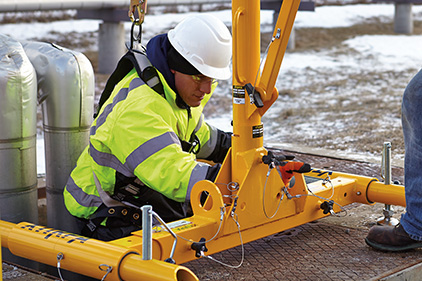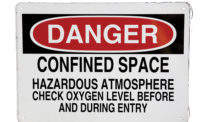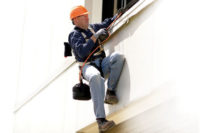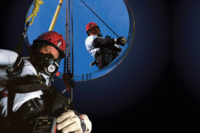The welder could be overcome by fumes. The farmer could be engulfed by corn. The city worker could slip and fall.
Just how often these accidents happen is unclear. That’s because these types of injuries are tracked based on the cause and not the location of the incident, including those among would-be rescuers. When a fatality occurs, for instance, it’s attributed to asphyxiation or a fall, not asphyxiation in a confined space or a fall from height within a confined space.
But the hazards that come with working in confined spaces are well documented. Consider: OSHA, ANSI and NFPA all have established, extensive regulations, standards or guidelines aimed at protecting people whose work takes them into confined spaces.
To address the dangers in these areas, here’s what you should know:
Does your confined space require a permit?
A confined space is officially defined as a space that is 1) large enough to enter; 2) not designed for continuous occupancy; and 3) has limited means of entry and exit. Along with water tanks, grain bins and manholes, common examples of confined spaces may include environments such as tunnels, vessels, silos, storage bins, pipelines and pits.
OSHA regulations require that if a known hazard exists in a confined space, the owner of that area must give or grant permission for an employee or contractor to enter the environment. Thus, it becomes a “permitted” space. Hazards could include a sloped floor in a vessel that could cause someone to slip, or poor air ventilation in a tunnel where fumes could concentrate.
Ideally, owners should make an effort to eliminate the hazard in the confined space, which may allow the space to be re-classified from a “permitted” confined space to simply a confined space.
Requirements and best practices for permitted spaces
Once a confined space is deemed permitted, the owner of the environment must comply with OSHA 1910.146. This regulation outlines requirements such as signage to alert workers to the potential hazard. These same regulations require atmospheric testing and ventilation requirements when necessary to help make the space safe. Owners must also develop and implement a rescue and retrieval plan that could include trained workers on site or external resources of emergency responders.
In permitted confined spaces, OSHA requires that a method for retrieving a downed worker be in place. Additionally, anyone who enters the permitted space must wear a full-body harness. Fall protection — which could include a guardrail system to help prevent workers from an exposed edge or an energy-absorbing lanyard connected to the worker’s harness — is required if the worker is exposed to a fall hazard of four feet or more in general industry or six feet or more in the construction industry.
Best practice is to treat all confined spaces as permitted spaces, even when they are not. Fill out a checklist to help ensure workers are safe every time they enter a confined space, permitted or not. That checklist should account for lockout/tagout procedures such as controlling hazardous energy sources or preventing flooding within the space.
Retrieval systems
Because confined spaces can be complicated environments, many safety retrieval systems are in demand for these applications. Rarely does a worker open up a manhole cover or enter a pipeline and go straight down into the environment. They often have to weave around obstructions or descend several stairways underground. These twists and turns can and often do complicate efforts to rescue stranded workers.
Retrieval systems are application-specific, so safety managers should consider the environment and the type of work being done, as well as a worker’s required range of motion within the space. Different systems are available for low clearance; some incorporate anchors for concrete, while others are available to attach to trucks or other vehicles that may serve as suitable anchors.
For applications that involve manholes and other similarly sized openings, collar systems are ideal. Metal collars are inserted to the opening and provide the anchor for davit arms and connected wires that can be attached to a worker’s harness for easy retrieval.
To protect confined space entry points from accidental entry, such as a manhole in a high-traffic pedestrian area, consider manhole guard systems that create a barricade around the entry point to help alert other people in the area that workers are present and help protect the work area.
Though retrieval systems are not required for all confined spaces, a good general practice is to have retrieval systems in place and on site in case the need for a rescue occurs.
Three-way self-retracting lanyards (SRLs) are ideal for confined space. As the name implies, these three-way SRLs perform three functions. They allow for free movement, similar to a self-retracting seatbelt where a person can move about and the cable goes with them. As workers climb a ladder, for example, they won’t get caught up in cable as it will follow behind them as they climb up or down.
Its second function is fall arrest. If a worker falls, the SRL will lock up and prevent the person from falling further.
The final function is as a retrieval device. By pulling a switch on the device, it will engage the retrieval function and allow attendants to raise or lower the entrant using the confined-space retrieval system.
Not all retrieval devices are manufactured to arrest falls. Even if the three-way SRL is hooked up, the structure it is attached to may not be engineered strongly enough to arrest the fall, and it could collapse if exposed to the impact forces of a fall. A best practice is to have a system that’s designed for both retrieval and fall arrest.
Retrieval options for horizontal spaces
Some people think confined spaces only refer to vertical spaces such as a manhole, but the very same hazards exist in lateral confined spaces such as an air duct. If a worker is 40 feet from the entry to an air duct, and they’re not hooked up to a retrieval system, how do you get them out if they can’t get out themselves?
Oftentimes, workers will hook up a rope to the harness of the person entering and consider that a retrieval system. Now the attendant outside the space is responsible for pulling that person out if a rescue becomes necessary.
But consider this scenario: A 200-pound person is working inside a confined space, and another person is outside the entrance responsible for the rope. The person inside suffers a medical emergency, leaving him unable to get out of the confined space by himself. Now the person outside is responsible for extracting her colleague, who is more than 200 pounds when friction is calculated into the weight load. This imbalance might not always ensure a prompt response.
Portable pole hoist systems are one of the most versatile systems for confined spaces and can be used for both vertical and horizontal confined spaces. These systems offer a wide range of lifting, lowering and positioning for workers entering horizontal spaces. They also offer a base for attaching a three-way SRL or other mechanical advantage system.
What harness should be used?
In a permitted confined space, according to OSHA 1910.146 all entrants must wear a chest or full-body harness. In many cases, a standard full-body harness is sufficient, but if there is a specific job task, such as welding or cleaning with abrasive materials, specialty harnesses that help protect against environmental hazards should be worn.
Another best practice when sending an employee into any confined space, even if it’s not a permitted confined space, is to wear a harness. Rescuers will have a much easier time extracting the person from a confined space if the person has a harness on. D-ring options on a harness should be considered based on the type of retrieval system being used. For example, shoulder D-rings on a harness can be used during retrieval from a vertical space.
Do you understand your confined space?
Addressing the dangers of a confined space begins with knowing the OSHA, ANSI and NFPA regulations, standards and guidelines aimed at protecting people whose work takes them into confined spaces. An assessment of your confined space can then identify the site-specific procedures and equipment needed for a safe working environment, and an efficient rescue if any accidents occur. Together, these steps will give you the thorough understanding you need of your confined space.



